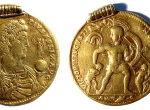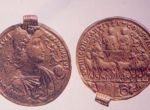Laskiv
Laskiv, Volodymyr-Volynskyi raion, Ukraine (former Polish name Łasków, pow. włodzimierski województwo wołyńskie), one of the largest early →Migration Period deposits in Europe discovered in 1609. A detailed record of objects belonging to this hoard, complete with their weight is found in Polish and Ruthenian archival sources and makes it possible to reconstruct the contents of this now mostly lost deposit. The recorded part of the hoard included a total of 18 gold and silver objects: seven gold Roman medallions with loops (figs. 1 and 2), a silver cup, two gold-plated silver brooches set with 24 garnets in Untersiebenbrunn-Rábapordány style →Sösdala-Untersiebenbrunn Style which have analogies in the second deposit from →Şimleul-Silvaniei, from →Zagorzyn and from Airan, Calvados department, four “small silver crosses” and four pieces of silver gilt sheet. The latter eight items presumably were elements of an ornate horse harness analogical to the find from the Jakuszowice deposit. The hoard from L. is dated to late 4th, possibly, first half of 5th century AD.
Analogies: →Jakuszowice , →Şimleul-Silvaniei, →Velp, →Zagorzyn
AB
Literature: E. I. De-Vitte, Archeologičeskaja nachodka v sele Laskove Vladimiro-Volynskago uezda v 1610 godu, Čtenija v istoričeskom obščestve Nestora-Letopisa, 14, II, 1900, p. 86-101; M. A. Tichanova, Laskovskij klad, Sovetskaja Archeologija 29, 1960, p. 196-204; A Bursche, Złote medaliony rzymskie w Barbaricum. Symbolika prestiżu i władzy społeczeństw barbarzyńskich u schyłku starożytności, Warszawa 1998, p. 66-69, 234-235.
-
 full resolution
full resolution
Fig. 1. 9-solidi medallion of Constans struck at Aquileia in 340, traced to the Laskiv deposit (Geldmuseum Deutsche Bundesbank, Frankfurt am Main).
-
 full resolution
full resolution
Fig. 2. 9-solidi medallion Constantius II struck at Antioch in 348-349, traced to the Laskiv deposit (Gosudartsvennyi Ermitaž, St. Petersburg, inv. no. 2142).


